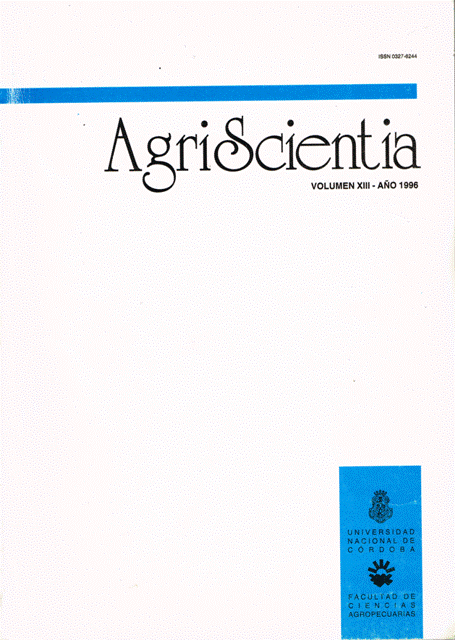Length of the rainfall cycle in the province of Córdoba (Argentina) and its use in the choice of alternative crops.
Main Article Content
Abstract
A method for predicting the duration of the rainy season at the onset is sought using three different methods to calculate the beginning, end, and length of the rainy season in semiarid and subhumid regions of Córdoba province, Argentina. Using multivariate analysis, a prediction function of the length of the growing season (DUR), based on the onset date (COM) and the geographic location (LONG) for each site, was obtained. Using historical information from departmental yield series, a suggested practice is assessed: if the onset of rains is delayed, sorghum should be favored over maize and vice versa. The suggested crop selection scheme was not practical in Río Cuarto department, but it seems useful in Río Segundo and Tercero Arriba (having a shorter mean length of the growing season), which produced an 84% fit with the observed performance and 68% with the prediction function.
Article Details

This work is licensed under a Creative Commons Attribution-ShareAlike 4.0 International License.
How to Cite
References
Brynsztein, S. M., & Vargas, W. M. (1991). Análisis de las fluctuaciones de corto período de las series de rendimiento de los cultivos en el partido de Tres Arroyos, Provincia de Buenos Aires. Anales del CONGREMET VI, Buenos Aires, Argentina, 71-72.
Cocheme, J., & Franquin, P. (1967). An agroclimatology survey of a semiarid area in Africa South the Sahara (TN No. 86). WMO.
de la Casa, A. C. (1993). Comparación entre agroclimas cuasihomólogos de la Provincia de Córdoba basada en atributos de riesgo. Agriscientia, 10, 55-61.
de la Casa, A. C., & Rodríguez, A. R. (1995). Sistemas agrícolas sugeridos y riesgos climáticos asociados en la Provincia de Córdoba (Argentina). Agriscientia, 12 (Número especial), 23-31.
Dennett, M. D., Rodgers, J. A., & Keatinge, J. D. H. (1983). Simulation of a rainfall record for the site of a new agricultural development: An example from Northern Syria. Agricultural Meteorology, 29, 247-258.
Prohaska, F. J. (1952). Regímenes estacionales de precipitación de Sudamérica y mares vecinos (desde 15°S hasta Antártida). Meteoros, Año II(1-2), 66-100.
Reddy, S. J. (1993). Agroclimatic/Agrometeorological techniques: As applicable to dry-land agriculture in developing countries. S. Jeevananda Reddy.
Rodríguez, A. R., & de la Casa, A. C. (1990). Regiones Hídricas de la República Argentina. Revista de Ciencias Agropecuarias (UNC), 7, 31-40.
Sivakumar, M. V. K. (1988). Predicting rainy season potential from the onset of rains in Southern Sahelian and Sudanian climatic zones of west Africa. Agricultural and Forest Meteorology, 42, 295-305.
Stewart, J. I. (1985). In International Conference on African Agricultural Development: Technology, Ecology and Society. California State Polytechnic University, USA.
Viglizzo, F. (1989). La interacción sistema ambiente en condiciones extensivas de producción (conferencia). Revista Argentina de Producción Animal, 9(4), 279-294.
Wallén, C. C. (1968). Agroclimatological studies in the Levant. In Agroclimatological methods: Proceedings of the Reading Symposium (pp. 225-234). UNESCO.
Wolcken, K. (1954). Algunos aspectos sinópticos de la lluvia en Argentina. Meteoros, Año IV(4), 327-366.





